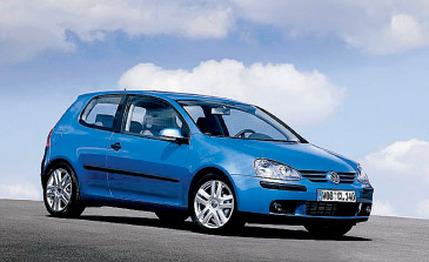 Mini Test Road Test
Mini Test Road Test
The 200-hp, 2.0-liter turbocharged GTI appeared as a "concept" at the Frankfurt show, just as lesser models of the fifth-generation Golf were about to go on sale in Germany. The GTI will be the first of the new Golfs to arrive in the U.S., and that won't be until early in 2005.
Car and Driver was among the first to drive the new Golf. Although our general conclusions should apply to the U.S. version—and the new Jetta sedan that will arrive here a few months later—the engine lineup will be different from that of the European launch models.
Evolution not revolution is the watchword at Volkswagen. The Golf series started in 1974 and has now overtaken the VW Beetle with more than 21.5 million total sales. Over 30 years the style has changed a lot, but from one model to the next the changes are more subtle. From gen four to gen five, you need to take a second glance to be sure you're seeing something new. Volkswagen likes it that way. No surprises, just a policy of continual improvement.
This is, however, a completely new car and, like its predecessors, forms the basis for a whole range of models from Volkswagen and its companion marques Audi, SEAT, and So koda. The Golf is VW's talisman and has at various times been Europe's bestselling car. But in the U.S. it takes second place to the Jetta—which isn't a great success back home in Germany.
The new Golf's mission was to increase the car's accommodations and quality and also to match the driving standards set in this class by the Ford Focus. So, as we have already seen with the new Audi A3, the Golf structure (80 percent stiffer than before) has given up its torsion-beam rear axle for an independent multilink arrangement featuring trailing arms, just as on the Focus. The steering has electric power assistance, and the Golf comes with electronic stability control standard. The interaction of these two systems makes for some sophisticated moves, such as automatic steering correction if the vehicle is deflected by a crosswind. Six-speed gearboxes are now the norm—both manual and automatic.
The result is a car that shows more confidence than its predecessor, can corner faster and more safely with less fuss, but is too sanitized to be really entertaining to drive. The quality of the cabin fittings is hard to fault, but they don't look very special. The new Golf has grown by a couple of inches, and the wheelbase, at 101.5 inches, is 2.2 inches longer than before. This has translated directly into extra passenger space, mostly in the rear seat.
The first European models have the 1.6-liter FSI (gasoline direct injection) or one of two diesel engines, the more modern of which is a 2.0-liter, 16-valve TDI developing 138 hp. Expect that diesel to be offered in the U.S. The GTI's 200-hp turbocharged 2.0-liter FSI engine will also make it to the States. So will the 3.2-liter VR6 in a new Golf R32. The Golf/Jetta's base powerplant will be a 2.5-liter inline five making 170 pound-feet of torque. VW says this five-cylinder is in effect half the Lamborghini Gallardo's V-10, but with only 150 hp, it makes far less than half the power.